Crisis Management
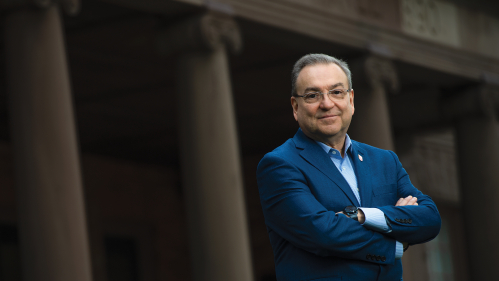
As the coronavirus pandemic bore down on the United States, the Rutgers COVID-19 Task Force, led by Antonio Calcado, worked around the clock to safeguard the university while facing a near tragedy of its own as members kept much of the research, education, and outreach mission moving.
When headlines on December 31, 2019, revealed that the government of Wuhan, China, was treating dozens of people sickened by a mysterious coronavirus, the news was not lost on Rutgers officials. Administrators at Rutgers Global, the university unit that oversees study abroad and other international programs, were concerned that Rutgers students studying in China might be in harm’s way. Officials contacted their counterparts in the divisions of student health and academic affairs. Others were taking note, too. In early January, Brian Strom, the executive vice president for health affairs, was already part of discussions about the likelihood of the coronavirus spreading. Meanwhile, Antonio Calcado, the executive vice president for strategic planning and operations and chief operating officer, Institutional Planning and Operations, had an eye on developments. Then on January 20, 2020, Japan, South Korea, and Thailand confirmed their first cases of what would soon be named COVID-19. As Strom, a renowned epidemiologist, had suspected, the disease was spreading. During the third week of February, a group of university leaders was convened to have a preliminary conversation about the coronavirus and its possible implications for the university. Just days later, on February 23, Italy reported an overnight surge in cases.
“That’s when we knew we had a problem,” says Calcado.
By the end of February, the university opened the Emergency Operations Center (EOC), located at Rutgers University–New Brunswick, and activated its emergency operations plan. Calcado again summoned top officials who represented a wide range of university operations—from academic affairs and human resources to information technology, facilities, and public safety—and the Rutgers COVID-19 Task Force was formed. Now it was official. “We went into full-bore mode,” he says. “We put our teams together, and each team—there were 14 of them—had a charge.” The question on everyone’s mind was: could they meet the challenges ahead?
“I was certainly concerned about the need to completely change the way we did business at Rutgers, but I don’t think any of us on the task force could have predicted the enormity of the challenges we would face in light of the pandemic,” says Barbara Lee, who stepped down as the senior vice president for academic affairs on June 30.
“Initially, knowledge of the pandemic led me to react with a certain amount of disbelief as I watched it play out across the world,” says Michele Norin, senior vice president and chief information officer. “When we activated the EOC, that’s when it hit home for me: ‘OK, this is real.’”
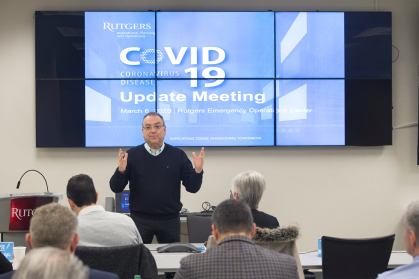
Calcado began leading daily meetings of the task force that started at 8 a.m., sharp, and were followed by daily briefings for the chancellors of Rutgers University–New Brunswick, Rutgers Biomedical and Health Sciences (RBHS), Rutgers University–Newark, and Rutgers University–Camden. The growing list of concerns to address was daunting. Every decision had a ripple effect, posing operational ramifications and presenting logistical puzzles to solve. If students were to be sent home and part of the university physically shuttered, how would this play out? How were the dorms to be emptied and cleaned? What steps would be necessary to safeguard members of the staff sanitizing heavily trafficked areas? And if much of university staff was working from home, how would they communicate with one another? What would it mean for ongoing research? And there were legal considerations, public safety concerns, procedural knots to untie. The list seemed endless.
“Early on, there were days when I wondered how I would even focus,” says Norin. “There was so much going on for us. And we were listening to the news. I had a few of those days where I told myself to stop listening to it and focus. I think everyone was going through that, to some degree.”
Task force members had embarked on what has been the most challenging episode in their higher education careers, an around-the-clock commitment that would call on their physical and psychological strength, demand optimum teamwork and institutional knowledge of Rutgers, and require staying one step ahead of the looming pandemic in order to safeguard the university community. “I was obviously concerned about what was to come; no one knew at the time,” says Kimberlee Pastva RC’01, NLAW’04, who is the secretary of the university. “I was ready to do whatever was needed, and I was proud of Rutgers, my alma mater, for getting prepared earlier than anybody else.”
Calcado was all business when it came to preparing for disasters; indeed, he thrived on the pressure. He had led meetings at the EOC many times to plan for big events such as snowstorms and hurricanes—even President Obama’s appearance to deliver Rutgers’ 250th Anniversary Commencement Address in 2016. “Preparing for Obama was challenging,” says Calcado. “But everyone had gone about their jobs with a smile on their face; it was a joyous occasion we were planning for. When you are looking at a pandemic, there are real people with real lives in real situations, and you can die.”
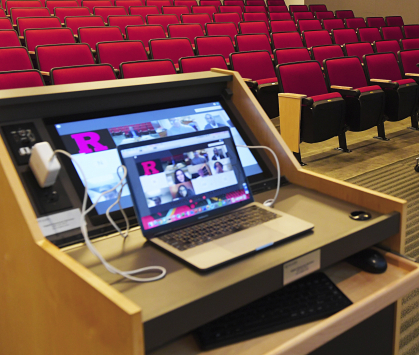
The first priority was to organize the safe return of students who were studying abroad—which would call on the expertise of the task force members working with the leaders of Rutgers Global and several units throughout the university. “Like others, I came to the table with a focus on getting our students back from overseas,” says Felicia McGinty, the executive vice chancellor of administration and planning at Rutgers–New Brunswick. “It became very apparent that just getting them home would be a challenge. It was intense.”
As the process unfolded, task force members were beginning to understand that the university was not going to be able to simply mitigate the problem and protect the campus. Students would have to go home and resume their studies through remote instruction to complete the school year, challenging as that was going to be. In short order, the university began emptying and then cleaning the residence halls, an enormous undertaking that underscored the work of the support staff in facilities and housing. “We have a dedicated staff that seldom gets the credit,” says McGinty. “They were the people on the ground making the magic happen.”
But there were complications. Close to 5,000 students of the 18,000 living in student housing at Rutgers–New Brunswick said they had nowhere to go. Rutgers–Newark and Rutgers–Camden, although having much smaller numbers of students living on campus, were reporting similar problems. The staff overseeing on-campus housing had to evaluate every claim and then make the difficult decision of allowing only a minimum number of students to remain.
As the Rutgers community was adjusting to the new reality of working from home, there was the not-so-small matter of providing students and faculty with the technology to continue instruction through remote learning. There were some students who didn’t have personal computers, who usually relied on those provided at university libraries, which were closing. Rutgers managed to supply laptops to many students so that they could go home and participate in online classes. Staff members would need assistance, too, and many of them, like some faculty and students, were facing the added challenge of providing home schooling for their children or caring for ill family members. By the time remote instruction began after spring break, leaders from the Office of Information Technology (OIT) and teams supporting academic technologies had already met several times to troubleshoot issues.
Fortunately, OIT’s comprehensive preparation in recent years meant the university was able to accommodate the new demands. “We had to add very little by way of tools to make sure that people were set up the way they needed to be,” Norin says. “If we had had to add tools, like Webex, in a week’s time, I’m not sure we would have been able to do it. It was nice to see it all come together.” The only real pressure on the system was the surge in questions to call-in centers, but OIT arranged for additional student workers to handle the added load, typical for the beginning of any semester.
Within a matter of weeks, the task force had reacted ably to managing the crisis: bringing students home from overseas; emptying residential housing and closing facilities; and providing members of the university community with the technology to carry on remotely. Rutgers was still operating. It felt like a small miracle had taken place. “I am enormously proud of all of my colleagues for rising to the occasion, with everyone pitching in to pivot our way of doing business—really on a dime,” says Lee. “When you think about how many students and faculty had to completely change the way they interacted; the way that the faculty taught their courses; the way that the students organized their learning; the way our staff continued their work from home (those that were able to), it has been amazing!”
At the end of each daily meeting of the task force, as leaders got ready to return to their teams to triage the pressing matters of the day, Calcado made a point of reminding everybody that, despite the enormous progress that the group was making, time was not on their side, that COVID-19 was nipping at their heels. As task force members rose to leave, their numbers dwindling as more chose to participate remotely, Calcado repeated his usual mantra: “Wash your hands. Don’t touch your face. And social-distance.”
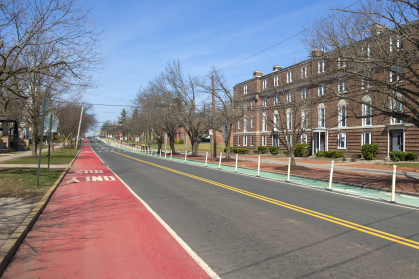
On Friday, March 27, at the conclusion of yet another meeting, Calcado looked over to McGinty, who was sitting a socially distanced four chairs down from him in the assembly room of Winants Hall at Rutgers–New Brunswick, where the group was now meeting. “You know, I’m exhausted,” he said. “I’m going home.” She understood; they were all worn out. Arriving at his home in Livingston, New Jersey, Calcado slumped on the couch and passed out. By Saturday morning, he was feeling worse and had developed a fever and a slight cough. The following morning, Calcado, now with a temperature of 104 and struggling to breathe, knew he was in trouble. He arrived at the emergency room at RWJBarnabas Hospital in Livingston, which quickly admitted him. He was diagnosed with double pneumonia. Test results would later reveal that he had contracted COVID-19.
“This thing had just crippled me—crippled me—within 24 hours,” he says. “I was taken down hard.”
Calcado spent the next week in the hospital—in isolation, alone with his darkening thoughts, and dependent on high-flow oxygen therapy to breathe. He was so weak that, after a while, he couldn’t respond to text messages from colleagues offering words of encouragement. “I wasn’t sure I was going to get through this one.”
The news of Calcado’s illness alarmed members of the task force. He was a force of nature, a personality that filled the room with his presence, facilitating the decision-making process and keeping the group in good spirits, and now he was down for the count. Wasn’t he supposed to be invincible? Calcado had thought so.
“Tony was the glue that was keeping the whole project together,” says Peter McDonough Jr., the senior vice president for external affairs. “When you are in a situation like this, when things are moving forward quickly, there is a whole lot of triaging that has to happen,” he says. “When Tony went down, it added anxiety to the whole process.”
“I was devastated by the news, shocked,” says Pastva. “I had always looked up to him as a mentor. I view some of the strongest people at the university, especially someone like Tony, as invincible. I was worried about him, and I was worried about the task force. Would things get lost in the mix if Tony wasn’t leading us? Fortunately, President Robert Barchi picked up the role and just ran with it.”
With Calcado gravely ill, members of the task force deepened their resolve and leaned into their roles, making themselves available in any way they could. McGinty, for one, had seen how Calcado had been carrying much of the load and was concerned that some vital detail or two stored in his mind might go unattended. Barchi, pinch-hitting for Calcado during his absence, witnessed for himself the efforts of task force members. “I can’t say enough about how diligently and tirelessly they worked to deal with every aspect of this unexpected and unprecedented way of operating,” Barchi says. “These people were working incredibly hard and in a constant spirit of collaboration and teamwork.”
After a week in the hospital, Calcado, still weak and 14 pounds lighter, returned home where he remained on oxygen for another seven days. He slowly began the process of reengaging with his colleagues, who gave him lots of remote hugs. Calcado was overwhelmed by the compassion of colleagues. “I could not imagine working with a finer group of people, who had such heartfelt concern for me throughout my ordeal,” he says. “I could feel it.”
By the week of April 20, he was back where he belonged, running meetings remotely, as he continued to regain his strength. Just as before, Calcado was the demonstrative conductor, eliciting top performances from his musicians—the university experts assembled around him. “I am not an expert in any of the areas that the leaders are addressing; I don’t know any of these things,” he says. “But what I do know is that we can’t let the perfect be the enemy of the good. To me, it’s more a case of ‘Can we make this happen?’ ‘Is it operational?’ I’m there to talk them through issues if they are overthinking them perhaps. It never fails that what these leaders have done is already way beyond what is good enough. It’s already excellent work.”
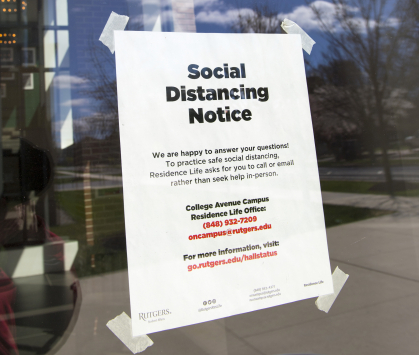
The work of the task force went on, although they had surmounted the crest of the crisis and now were looking at maintaining university operations and beginning to consider how the university would function in the near future. Team leaders, still rising with the sun and knocking off hours after dinner, continued to fill their days with meetings, now taking place less frequently, and with follow-up calls and emails to their administrative and operations teams. Like everyone else, weeks of homebound isolation and monotony was the new norm. “It’s Groundhog Day every day,” says McDonough.
Despite being forced to work remotely, the task force has been successfully managing the university’s response to the COVID-19 crisis. It has gone from an all-hands-on-deck reaction to the fast-moving events to finding the means to mitigate the possibility of an outbreak at Rutgers. In the process, the emergency has reinforced for colleagues their regard for one another, with many exceeding the high standards for which he or she was already known. “There have been so many moments when I have pride for the task force and for Rutgers,” says McGinty. “It’s been amazing to look around and see these experts in every area of the university. We have made decisions in the best interest of the community—just doing the right thing for the right reason. And it has paid off. Rutgers has been figuring it out.”
I am enormously proud of all of my colleagues for rising to the occasion, with everyone pitching in to pivot our way of doing business—really on a dime.
Barbara Lee
former Senior Vice President for Academic Affairs
Strom, who in addition to being the executive vice president for health affairs is the chancellor of RBHS, has participated on task forces at other universities. For him, the response of the Rutgers COVID-19 Task Force stands out. “Rutgers has done a fantastic job of handling this terrible situation,” he says. “The task force, pulling together all of the relevant leaders across the university, responded to the crisis in a coordinated, planned, and rapid fashion. This has been an absolute model of how an institution should respond to a crisis.”
With the school year concluding, members of the task force were in the midst of mapping out the recovery phase for the university. What will Rutgers look like in the future and how will it prepare for it? The team has come up with several scenarios and is devising an action plan for each of them. One option is that Rutgers will return to normal—unlikely given the scientists’ prediction about the course of the virus. A second scenario is a hybrid approach where some instruction will be done remotely and some face-to-face, but with extensive social distancing, testing, contact tracing, and other measures recommended by public health authorities. A third consideration is a fall semester with instruction delivered remotely, the possible exception being in-person clinical instruction for some RBHS students. If an all-remote instructional delivery model is necessary, the faculty will continue to be assisted in improving their knowledge of and skills with technology so that they can optimize their instruction.
“This crisis was the most difficult challenge I faced in my 38 years at Rutgers,” says Lee. “I was sad to leave at this really difficult and challenging time. But I am confident that Rutgers will be fine. We have excellent leadership, committed faculty and staff, and our students have been really patient and understanding with respect to the challenges that we are facing and will continue to face for the foreseeable future.”